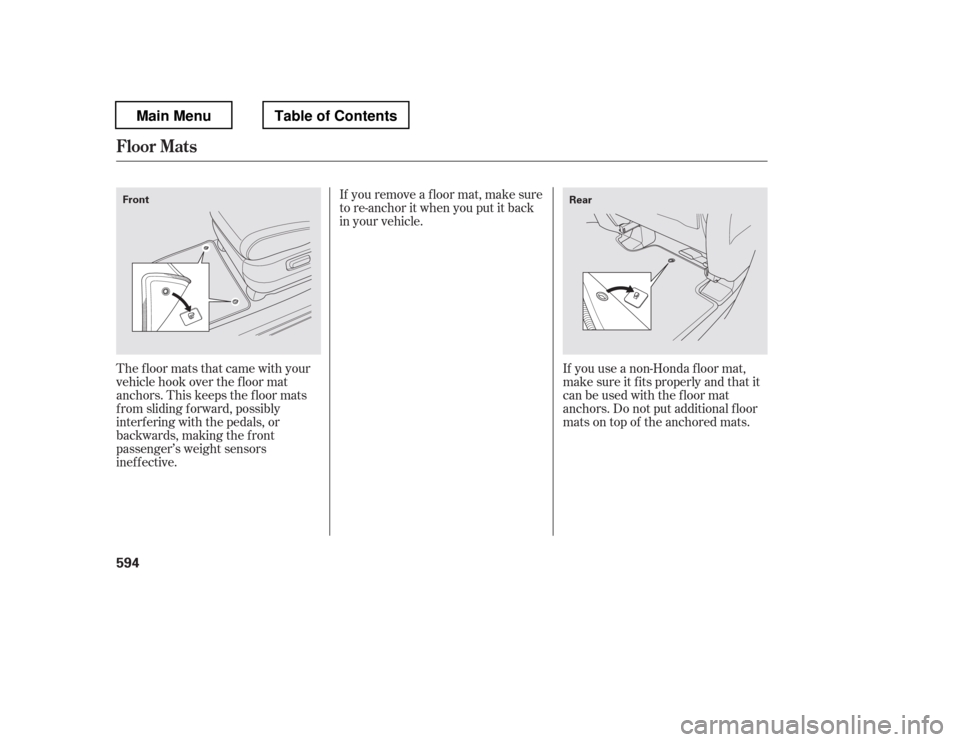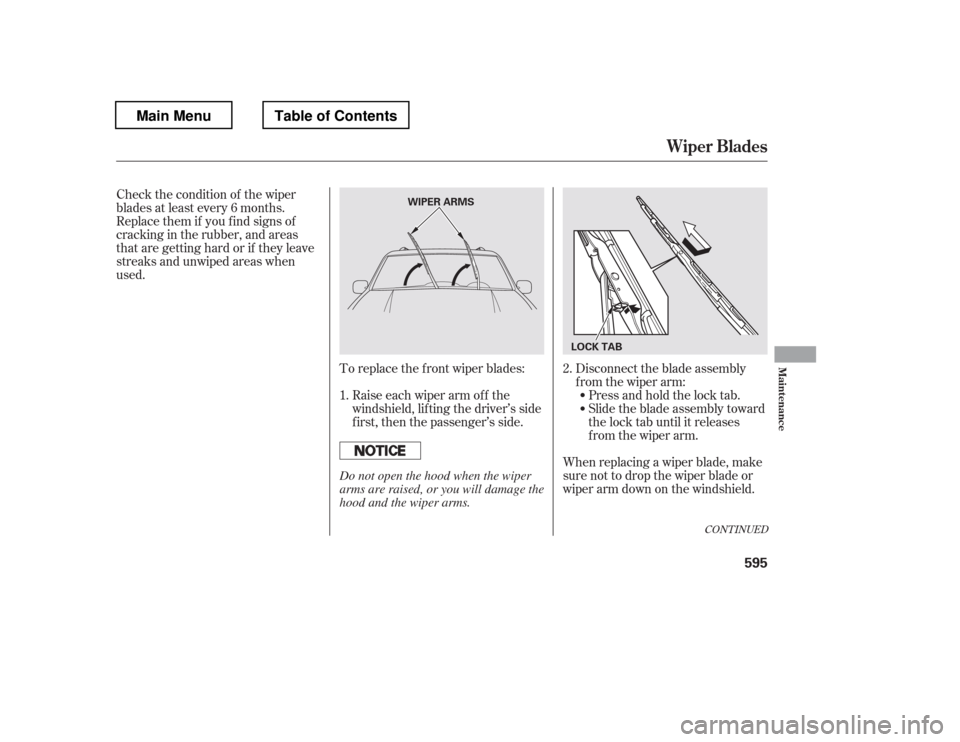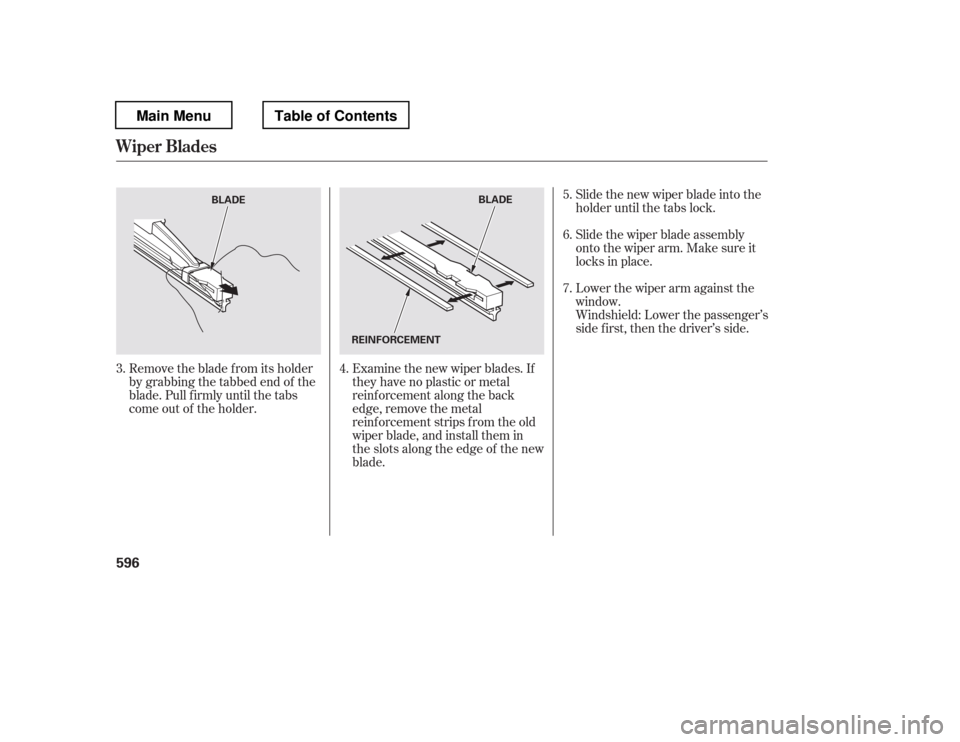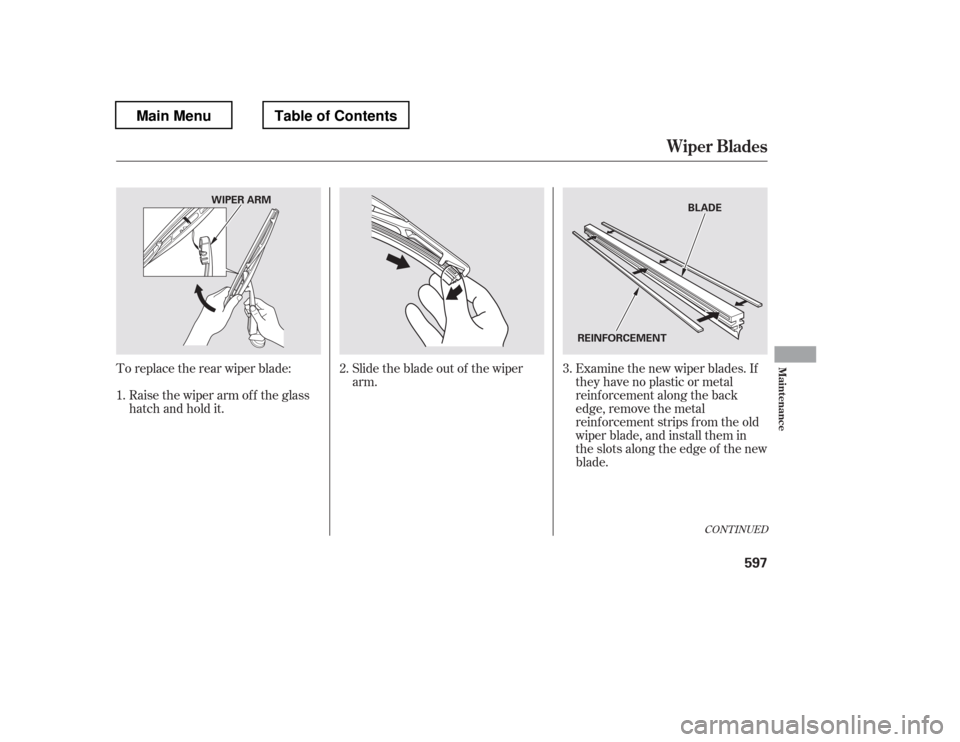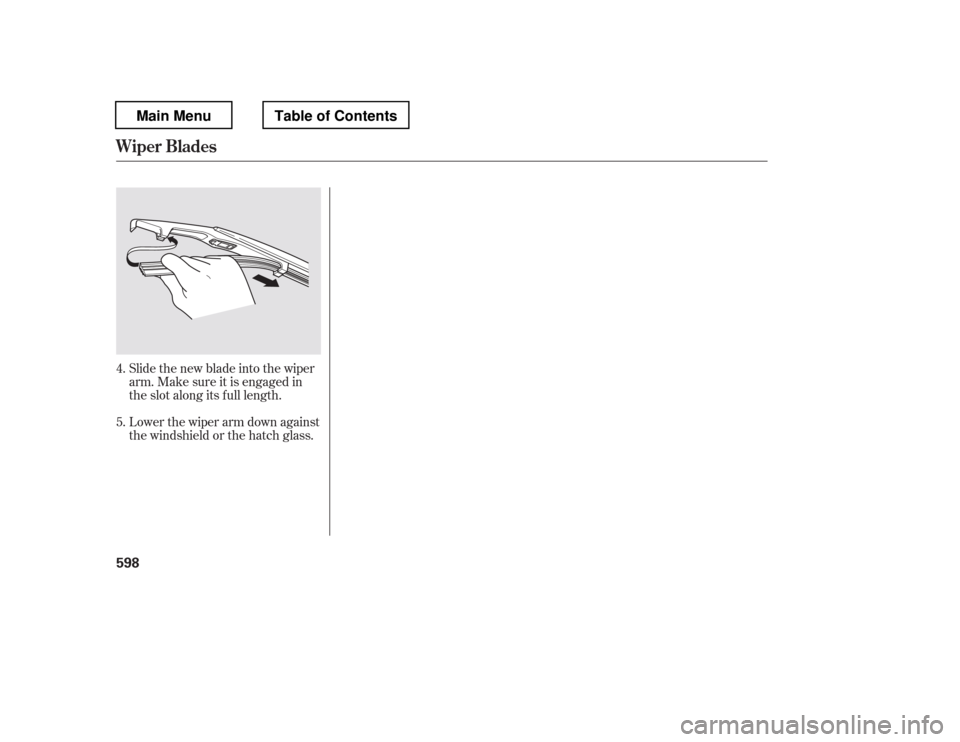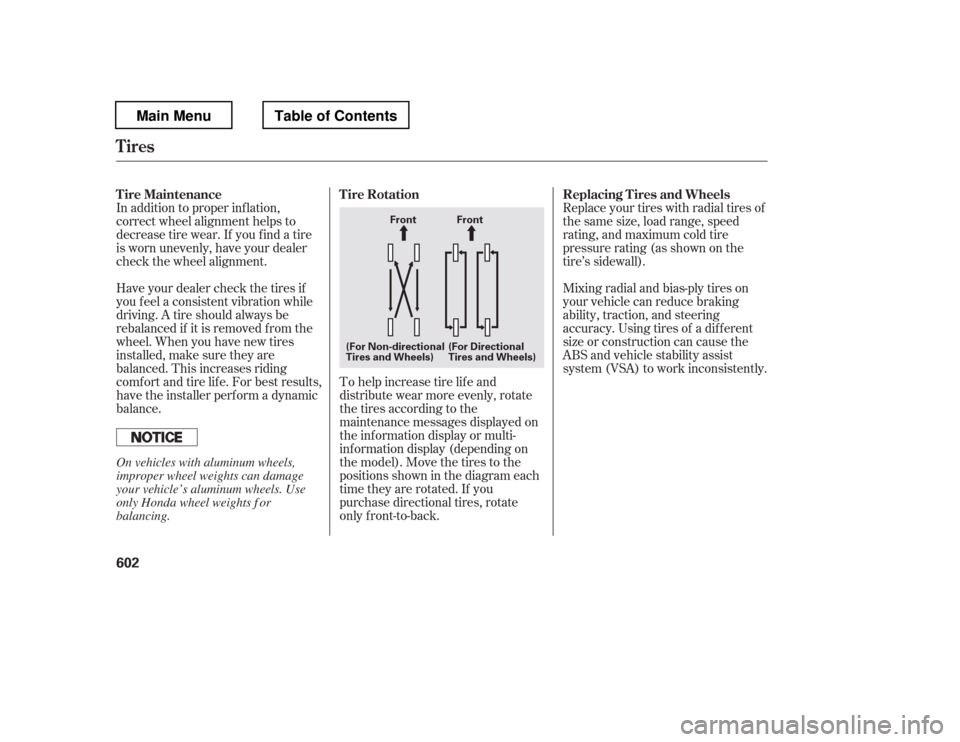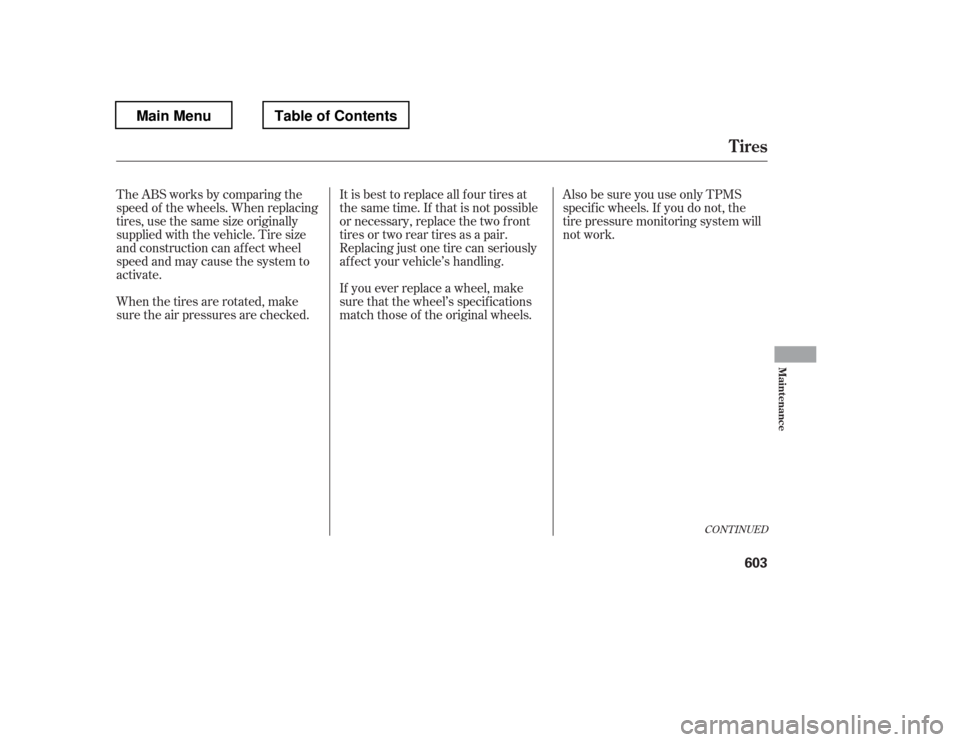HONDA PILOT 2012 2.G Owners Manual
PILOT 2012 2.G
HONDA
HONDA
https://www.carmanualsonline.info/img/13/6013/w960_6013-0.png
HONDA PILOT 2012 2.G Owners Manual
Trending: mirror controls, radio, change wheel, power steering fluid, sat nav, transmission, oil level
Page 601 of 681
The floor mats that came with your
vehicle hook over the f loor mat
anchors. This keeps the f loor mats
f rom sliding f orward, possibly
interf ering with the pedals, or
backwards, making the f ront
passenger
Page 602 of 681
Check the condition of the wiper
blades at least every 6 months.
Replace them if you f ind signs of
cracking in the rubber, and areas
that are getting hard or if they leave
streaks and unwiped areas when
used.To replace the f ront wiper blades:Raise each wiper arm of f the
windshield, lif ting the driver
Page 603 of 681
Examine the new wiper blades. If
they have no plastic or metal
reinf orcement along the back
edge, remove the metal
reinf orcement strips f rom the old
wiper blade, and install them in
the slots along the edge of the new
blade.Slide the new wiper blade into the
holder until the tabs lock.
Slide the wiper blade assembly
onto the wiper arm. Make sure it
locks in place.
Lower the wiper arm against the
window.
Windshield: Lower the passenger
Page 604 of 681
Toreplacetherearwiperblade: Slidethebladeoutof thewiperarm.Examine the new wiper blades. If
they have no plastic or metal
reinf orcement along the back
edge, remove the metal
reinf orcement strips f rom the old
wiper blade, and install them in
the slots along the edge of the new
blade.
Raise the wiper arm of f the glass
hatch and hold it.
3.
1. 2.
CONT INUED
Wiper Blades
Maint enance
597
BLADE
REINFORCEMENT
WIPER ARM
Main MenuTable of Contents
Page 605 of 681
Slide the new blade into the wiper
arm. Make sure it is engaged in
the slot along its f ull length.
Lower the wiper arm down against
the windshield or the hatch glass.
4. 5.
Wiper Blades
598
Main MenuTable of Contents
Page 606 of 681
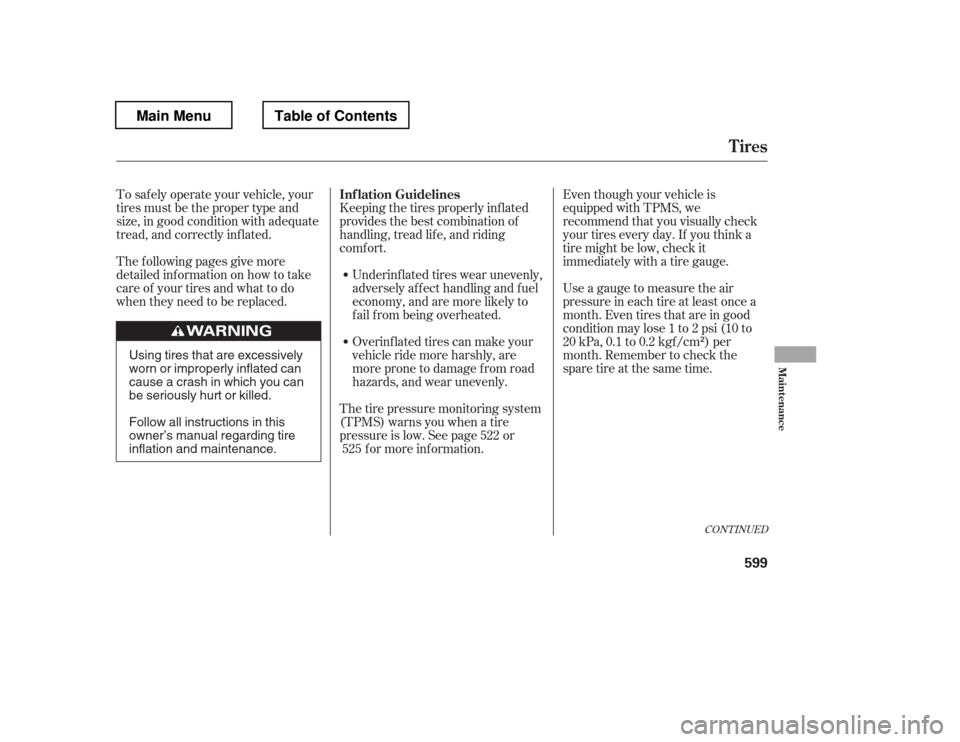
To saf ely operate your vehicle, your
tires must be the proper type and
size, in good condition with adequate
tread, and correctly inf lated.Keeping the tires properly inf lated
provides the best combination of
handling, tread lif e, and riding
comf ort.
The f ollowing pages give more
detailed inf ormation on how to take
care of your tires and what to do
when they need to be replaced. Underinf lated tires wear unevenly,
adversely affect handling and fuel
economy, and are more likely to
fail from being overheated.
Overinf lated tires can make your
vehicleridemoreharshly,are
more prone to damage f rom road
hazards, and wear unevenly.
Thetirepressuremonitoringsystem
(TPMS) warns you when a tire
pressure is low. See page or f or more inf ormation. Even though your vehicle is
equipped with TPMS, we
recommend that you visually check
your tires every day. If you think a
tire might be low, check it
immediately with a tire gauge.
Use a gauge to measure the air
pressure in each tire at least once a
month. Even tires that are in good
condition may lose 1 to 2 psi (10 to
20 kPa, 0.1 to 0.2 kgf /cm ) per
month. Remember to check the
sparetireatthesametime.
522
525
CONT INUED
Inf lation Guidelines
Tires
Maint enance
599
Using tires that are excessively
worn or improperly inflated can
cause a crash in which you can
be seriously hurt or killed.
Follow all instructions in this
owner
Page 607 of 681
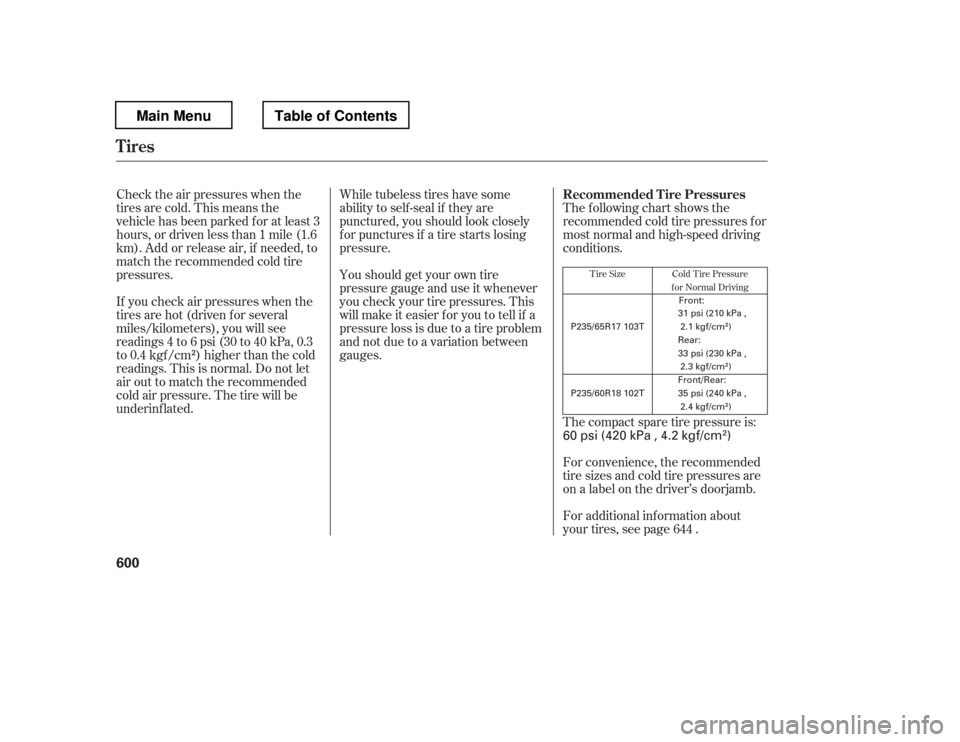
Tire Size Cold Tire Pressurefor Normal Driving
The following chart shows the
recommended cold tire pressures f or
most normal and high-speed driving
conditions.
Check the air pressures when the
tires are cold. This means the
vehicle has been parked f or at least 3
hours, or driven less than 1 mile (1.6
km). Add or release air, if needed, to
match the recommended cold tire
pressures. While tubeless tires have some
ability to self -seal if they are
punctured, you should look closely
for punctures if a tire starts losing
pressure.
Youshouldgetyourowntire
pressure gauge and use it whenever
you check your tire pressures. This
will make it easier f or you to tell if a
pressure loss is due to a tire problem
and not due to a variation between
gauges.
If you check air pressures when the
tires are hot (driven f or several
miles/kilometers), you will see
readings4to6psi(30to40kPa,0.3
to 0.4 kgf/cm ) higher than the cold
readings.Thisisnormal.Donotlet
air out to match the recommended
cold air pressure. The tire will be
underinf lated.
For additional inf ormation about
your tires, see page .
Thecompactsparetirepressureis:
For convenience, the recommended
tire sizes and cold tire pressures are
on a label on the driver
Page 608 of 681
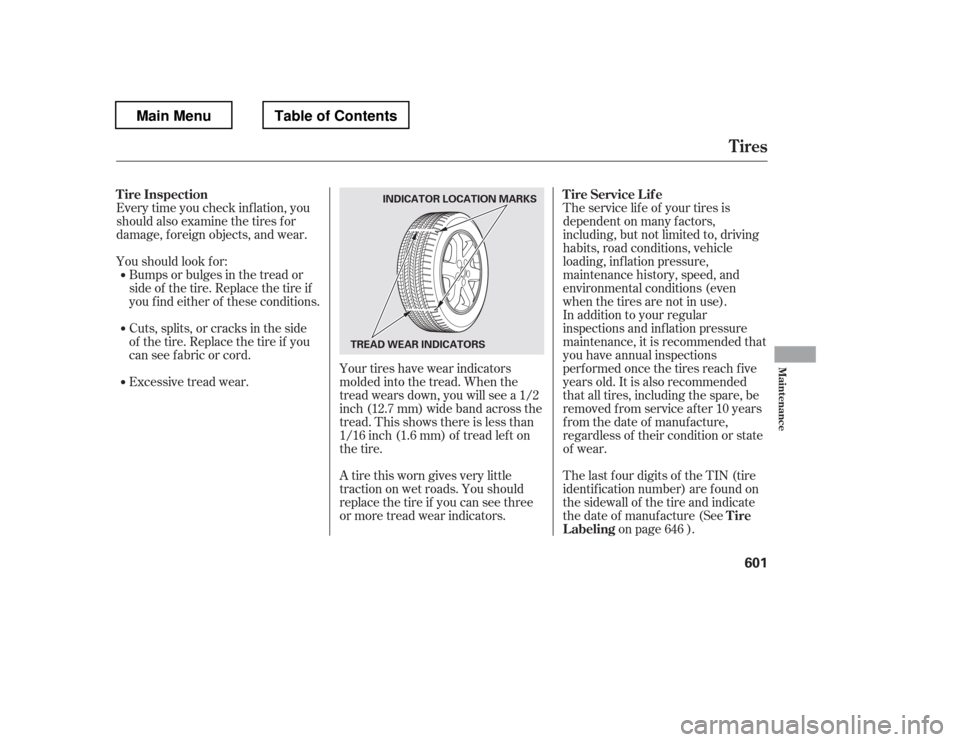
A tire this worn gives very little
traction on wet roads. You should
replace the tire if you can see three
or more tread wear indicators.
Every time you check inf lation, you
should also examine the tires f or
damage, f oreign objects, and wear.
Youshouldlookfor:
Bumps or bulges in the tread or
side of the tire. Replace the tire if
youfindeitherof theseconditions.
Cuts, splits, or cracks in the side
of the tire. Replace the tire if you
can see f abric or cord.
Excessive tread wear. The service lif e of your tires is
dependent on many f actors,
including, but not limited to, driving
habits, road conditions, vehicle
loading, inf lation pressure,
maintenance history, speed, and
environmental conditions (even
when the tires are not in use).
In addition to your regular
inspections and inf lation pressure
maintenance, it is recommended that
you have annual inspections
perf ormed once the tires reach f ive
years old. It is also recommended
that all tires, including the spare, be
removed f rom service after 10 years
from the date of manufacture,
regardless of their condition or state
of wear.
Your tires have wear indicators
molded into the tread. When the
tread wears down, you will see a 1/2
inch (12.7 mm) wide band across the
tread. This shows there is less than
1/16 inch (1.6 mm) of tread lef t on
the tire.
The last f our digits of the TIN (tire
identif ication number) are f ound on
the sidewall of the tire and indicate
the date of manufacture (Seeon page ).646
Tire Inspection
Tire Service Lif e
Tire
Labeling
Tires
Maint enance
601
TREAD WEAR INDICATORS INDICATOR LOCATION MARKS
Main MenuTable of Contents
Page 609 of 681
In addition to proper inf lation,
correct wheel alignment helps to
decrease tire wear. If you f ind a tire
is worn unevenly, have your dealer
check the wheel alignment.
Have your dealer check the tires if
you f eel a consistent vibration while
driving. A tire should always be
rebalanced if it is removed f rom the
wheel. When you have new tires
installed, make sure they are
balanced. This increases riding
comf ort and tire lif e. For best results,
have the installer perform a dynamic
balance.Replace your tires with radial tires of
the same size, load range, speed
rating, and maximum cold tire
pressure rating (as shown on the
tire
Page 610 of 681
TheABSworksbycomparingthe
speed of the wheels. When replacing
tires,usethesamesizeoriginally
supplied with the vehicle. Tire size
and construction can affect wheel
speed and may cause the system to
activate.
When the tires are rotated, make
sure the air pressures are checked.It is best to replace all f our tires at
thesametime.If thatisnotpossible
or necessary, replace the two f ront
tires or two rear tires as a pair.
Replacing just one tire can seriously
af f ect your vehicle
Trending: parking brake, suspension, engine coolant, tires, roof rack, lights, center console
